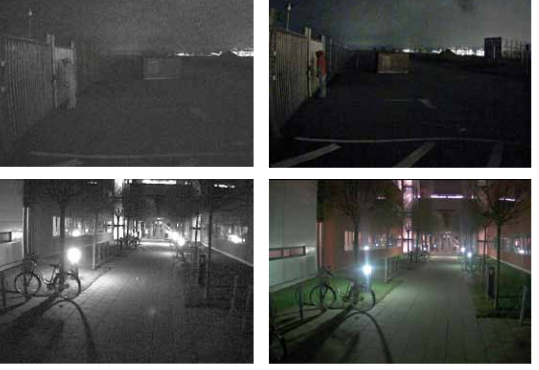Forget image quality - usability is key
In the world of consumer electronics, cameras need to deliver vibrant and colorful images. Camera makers integrate sophisticated image processing technology and fine-tune their pro...


In the world of consumer electronics, cameras need to deliver vibrant and colorful images. Camera makers integrate sophisticated image processing technology and fine-tune their products to meet consumer expectations as to what is a great looking image. This generally means that consumer electronics products will alter images and that results do not resemble an accurate depiction of the recorded scene. This is very much wanted and expected by consumers. They want beautiful images.
For video surveillance applications in the security industry it is of uttermost importance that images are recorded with as much detail as possible to allow for proper identification of people, vehicles and objects. In that, colors need to resemble the actual colors in the recorded scene. The requirements for consumer electronics and security industry solutions could therefore not differ more and the term image quality stands for something quite different in both worlds.
Yet the performance of video surveillance cameras is often described as image quality. Given there are very specific needs and use cases for video surveillance, it is necessary to determine how images will be used and what detail will be required. This aspect is best described by the term image usability. It describes the true performance of video surveillance cameras as relevant for a specific application and environment.
Image usability can not be measured in numbers
Consumer electronics are often marketed with a strong focus on technical specifications such as a certain pixel resolution. Consumers have grown accustomed to this practice and compare products by these numbers. Even in the security industry video surveillance cameras are sometimes marketed putting to the forefront technical specifications such as a certain megapixel resolution or lux light sensitivity.
While these numbers describe the technical capabilities of individual camera components, there are many more aspects to achieving optimal image usability for a specific application and environment these numbers alone simply can not express. Image usability can probably best be defined as meeting the operational requirements of a given video surveillance scenario. Can a person be identified? Was it a blue or a green car? Are there any objects obstructing the gate? Can a license plate number be recognized?
Being able to answer these questions with video surveillance footage determines image usability. Different applications and environments pose very specific challenges to a video surveillance camera. In consequence, there can be no one-fits-all camera model. The most important question to ask is how images will be used and what detail they will need to deliver. Then this needs to be looked at from the point of view of the possible mounting locations for a camera. Once a mounting location has been identified the specific challenges of this camera position need to be evaluated and a suitable camera needs to be chosen accordingly.
Seeing into the shadows with Wide Dynamic Range technology
In a setting with both very bright and very dark areas, a typical camera would produce an image where objects and people in the bright or dark areas would hardly be visible and could not be properly identified. This challenge is commonly faced when monitoring parking garage entrances or sun-lit foyers of buildings. However it can also play an important role in scenarios where this challenge may not be so easily identified at first thought such as for example when monitoring a corridor in an office building and trying to identify a person standing in front of a bright window on a sunny day. It is therefore important to consider a variety of different scenarios a camera may be subjected to in a particular location.
Wide Dynamic Range technology enables cameras to provide homogeneous images. This allows for identification of people, vehicles and objects no matter if they are in a very bright or very dark zone of the camera's field of view. Wide Dynamic Range cameras overcome this problem by applying techniques such as using different exposure times for different objects in a scene coupled with advanced image processing capabilities to enable objects in both bright and dark zones to be clearly identified.
Large yet detailed overviews with HDTV resolution cameras
In many application scenarios there is a need to cover a busy area with an overview and at the same time to be able to identify details once an incident has occurred. This includes for example retail store checkouts, airport passport controls, casino tables or multi-lane roads. The challenge is that until an incident occurs it is unknown which area will need to be looked at in detail. In a retail store checkout scenario it may be necessary to clearly see every item a customer is purchasing. For multi-lane roads the ability to clearly identify vehicle license plates is crucial for law enforcement.
HDTV resolution cameras offer a wide overview coupled with the ability to identify details. They provide images that are more useful, with more image detail and with wider coverage than standard resolution cameras. In a shopping mall scenario for example, the primary objective of a camera installation may be to watch for the presence of people and to view their movements. However should an incident occur, HDTV resolution cameras offer the required detail to be able to better identify a specific person.
Seeing in the dark with Axis Lightfinder technology
Conventional day and night cameras switch to black and white in darkness. There are however many situations where surveillance video with color is an important factor for effectively identifying people, vehicles and objects. Most of the time it will not possible to equip loading bays, parking lots or university campuses with flood lights and operate them during the entire night. Cameras operating with infra-red or thermal technologies can see in the dark but not in color.
Axis Lightfinder technology enables cameras to capture color video even in very dark and extreme low-light conditions. Suitable for both indoor and outdoor use, cameras with Lightfinder technology are the perfect solution whenever color video is required for better identification of people, vehicles and objects. Common low-light applications include parking lots, schools and campuses, construction sites, perimeters of power plants, water treatment plants and prisons, loading bays as well as railway surveillance. Indoor uses are for example only partially lit storage rooms and factory floors.
There is no one-fits-all camera model
Image usability is the one all-important factor in video surveillance. We are often mislead by the consumer electronics world that technical specifications such as a certain pixel resolution warrant a certain image quality. When looking at the specific challenges of different video surveillance applications and environments however it quickly becomes clear that only a careful assessment of all the environment parameters can lead to the correct specification of what type of camera is truly needed in order to achieve optimal image usability.
Business Partner
Axis Communications ABGränden 1
223 69 Lund
Sweden
most read

VIP-Lounge Interview: Marco Mille, Global Head of Security, Siemens AG
VIP in the World of Security: Marco Mille, Global Head of Security at Siemens AG

When the Internet stumbles: Why DNS is important
When DNS fails, the internet stumbles-AWS outage proves resilience and redundancy are vital for digital trust

GIT SECURITY AWARD 2026 - The winners have been announced!
GIT SECURITY AWARD 2026: The best safety and security solutions of the year - now an overview of all winners

What Does Ethical AI Governance Look Like in Practice?
The InCyber Briefing will explore AI, post-quantum readiness, data sovereignty, and crisis simulation

Assa Abloy's battery-powered Aperio KL100 secures lockers
Boost workplace security and operational flexibility by securing more than just doors.








